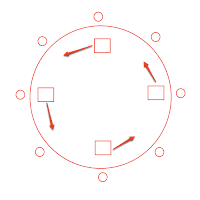Why teacups? While sitting around a round table during a team retrospective where we had mentioned pair programming the conversation drifted a little when someone said it felt like we were sitting in a teacup ride or something. Naturally, this led to combining the two ideas and teacup programming was born.
The idea is based on amusement park rides where the rider spins a wheel in the centre of the ride to increase the spinning velocity of the rider's individual car. The most widely known example of this is the Teacup ride at Disneyland.
Requirements
- An even number of programmers
- a table (round is preferred but not necessary and a rotating table is even better)
- one computer for every two programmers
Steps
1. Sit the programmers around the table with a computer in front of every other programmer.
 |
| table setup |
 |
| pairs with person to the right |
 |
| rotate the table one spot |
 |
| after rotation |
 |
| again pair with person to the right |
Variant
 |
| programmers "leap-frog" |
We have yet to actually try this out and so cannot say whether it is a viable technique or not but I think it does have some merit and there may even be some specific situations where it might be best applied such as at a hack-a-thon where there is a long list of problems or bugs trying to be solved none of which are too lengthy or difficult or for practicing for a programming contest where people are just trying to solve as many problems as possible.
If anyone gets around to actually attempting this please post a comment with the results.
No comments:
Post a Comment